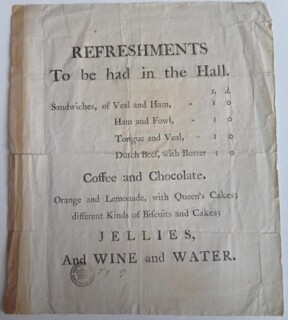Sandwiches at an Impeachment
Esther Chadwick
The seven-year trial of Warren Hastings for high crimes and misdemeanours while governor-general of Bengal began in 1788. 'There have been spectacles more dazzling to the eye,' Macaulay wrote in 1841,
more gorgeous with jewellery and cloth of gold, more attractive to grown-up children, than that which was then exhibited at Westminster; but, perhaps, there never was a spectacle so well calculated to strike a highly cultivated, a reflecting, and imaginative mind... Every step in the proceedings carried the mind either backward, through many troubled centuries, to the days when the foundations of our constitution were laid; or far away, over boundless seas and deserts, to dusky nations living under strange stars, worshipping strange gods, and writing strange characters from right to left. The High Court of Parliament was to sit, according to forms handed down from the days of the Plantagenets, on an Englishman accused of exercising tyranny over the lord of the holy city of Benares, and over the ladies of the princely house of Oude.
Westminster Hall was fitted out to accommodate two thousand spectators; a fire engine was stationed inside in case of accident. 'All the Lords in England are ordered to attend,' the Morning Post announced in January 1788, 'nor will any excuse be taken for absenting themselves, but sickness; and not that, unless two physicians appear personally and vouch it to be a fact.' Still, these people had to eat. On 12 February, Sarah Sophia Banks, whose great collection of ephemera is in the British Museum, received a ticket of admission to the Great Chamberlain’s Box for the duration of the trial. A week later she picked up the sandwich menu.

Comments
-
20 May 2015
at
5:24pm
jaspreetsinghboparai
says:
Veal & ham, ham & fowl, tongue and veal, 'Dutch beef' -- these all sound a bit like pies.... What exactly is 'Dutch beef'? Precisely that, or some sort of beefy variation on scrapple or white pudding? Curious as to why it's the only one with butter....
-
22 May 2015
at
3:49pm
outofdate
says:
@
jaspreetsinghboparai
Slow-braised vinegared beef or Sauerbraten probably (as opposed to roast beef), which would benefit from butter to take the edge off: 'Later on people started to use cheap beef cuts, only suitable for eating after cooking them a long time and tenderizing them with an acid, and cheap vegetables like onion.' http://honestcooking.com/hachee-dutch-beef-stew-recipe/
-
22 May 2015
at
4:12pm
jaspreetsinghboparai
says:
@
outofdate
Thank you for clarifying -- yes, what I had pictured was a little more like meat loaf or scrapple, neither of which needs butter to be delicious (or nauseating, as the case may be). A shilling sounds a bit steep for this sort of sandwich -- even if it were made by the contemporary equivalent of Peyton & Byrne....
-
22 May 2015
at
9:46pm
Timothy Rogers
says:
@
jaspreetsinghboparai
Yes,the shilling per sandwich caught my eye too. It seems pricey for a snack circa 1790, but maybe it was larger than the current model or intended only for nobs.
-
26 May 2015
at
9:39am
Alan Benfield
says:
@
jaspreetsinghboparai
I suspect the 'Dutch Beef' referred to is most likely to be pekelvlees, which is a sort of salt beef (like pastrami) which probably originated in the Jewish community of Amsterdam. It is made from rolled Beef brisket. It was also very popular during Dutch colonial times, as it was pickled and could be taken along on long sea voyages without spoiling, if preserved in wine or vinegar.
-
1 June 2015
at
11:07am
outofdate
says:
@
Alan Benfield
Neither it seems. (Pekelvlees just means Poekelfleisch or salt-preserved meat):
-
1 June 2015
at
3:16pm
Alan Benfield
says:
@
outofdate
Thanks for the link and well done for finding it. Coincidentally, it was written by an old friend of mine, Paul Brewin (we used to work together), but I had never read it.
Read morehttp://www.smulweb.nl/recepten/755901/Zelf-pekelvlees-maken
As nice as braised beef is (known as 'Hachée' in Dutch, which belies its name, as the meat is diced, not chopped or minced) I doubt anyone would try to make a sandwich of it: it's a rather liquid stew.
'Dutch beef – rubbed with butter, sugared and smoked by hanging in a chimney for several weeks.
...
To make Dutch-beef ; a very good Way (1714)
TAKE eight pound of Buttock-Beef without Bone, rub it all over with six ounces of coarse Sugar; let it lie two Days, then wipe it a little; then take six ouncesof Salt-petre beaten, a pint of Petre-salt, and a pint of White Salt, rub it well in, and let it lie three Weeks, rubbing and turning it
every Day, then sew it up in a Cloth and hang it in your Chimney to dry; turn it upside-down every Day, that the Brine do not settle: Boil it in Pumpwater 'till 'tis very tender.
Mrs Kettilby,
A Collection of Above Three Hundred Receipts in Cookery.'
https://sophiecoeprize.files.wordpress.com/2012/12/dutch-way.pdf
What is described is essentially pickled beef which is then smoked. All such preparations require the application of sugar, salt and saltpetre (which gives the meat its dark red colour), which are then allowed to infuse into the meat in order to preserve it. In using 'buttock meat' (presumably rump?) they use a better cut than is used for most pastrami and pekelvlees, which is usually made with brisket.
Well, I was half-way there...